化学转化膜
- 格式:ppt
- 大小:1.34 MB
- 文档页数:109
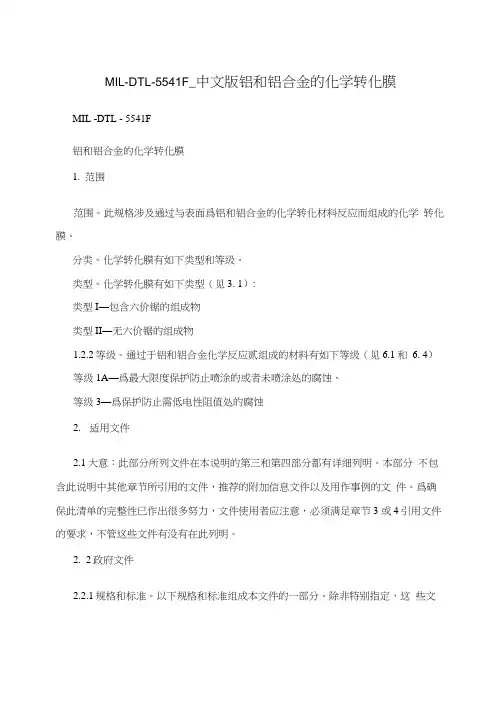
MIL-DTL-5541F_中文版铝和铝合金的化学转化膜MIL -DTL - 5541F铝和铝合金的化学转化膜1.范围范围。
此规格涉及通过与表面爲铝和铝合金的化学转化材料反应而组成的化学转化膜。
分类。
化学转化膜有如下类型和等级。
类型。
化学转化膜有如下类型(见3. 1):类型I—包含六价锯的组成物类型II—无六价锯的组成物1.2.2等级。
通过于铝和铝合金化学反应贰组成的材料有如下等级(见6.1和6. 4)等级1A—爲最大限度保护防止喷涂的或者未喷涂处的腐蚀、等级3—爲保护防止需低电性阻值处的腐蚀2.适用文件2.1大意:此部分所列文件在本说明的第三和第四部分都有详细列明。
本部分不包含此说明中其他章节所引用的文件,推荐的附加信息文件以及用作事例的文件。
爲确保此清单的完整性已作出很多努力,文件使用者应注意,必须满足章节3 或4引用文件的要求,不管这些文件有没有在此列明。
2.2政府文件2.2.1规格和标准。
以下规格和标准组成本文件的一部分。
除非特别指定,这些文件的问题引用在恳请或合同中。
联邦标准(这些文件副本可从SAE获得或从网站了解到)2.4优先级别。
如果发生此文件文字部分与此引用的参考相冲突,优先考虑本文件的文字部分。
然而,文件中任何条款都不能超越适用法律及规章,除非获得特殊赦免。
3.要求3.1材料。
如果没有规定材料类型,使用类型I。
除非在合同或订单中有声明,类型I代替类型II,或者类型II代替类型I,都是不允许。
用来生産化学转化膜的材料应就选择类型、等级、形式及申请方法等方面受批准,使其与MIL- DTL-81760相符合并且应已被接受列入适用合格産品清单(见6. 5)。
补充化学物质,如加入浴室中维持其效率的氟化物,应不能减少所应用膜的性能。
3.2清洗。
涂覆前,底部金属应机械或化学清洗,使得冲洗过后获得一个water break-free的表面。
含带研磨料类铁如钢丝网、铁氧化物、红铁粉或者钢丝线在所有清洗操作中均不允许。
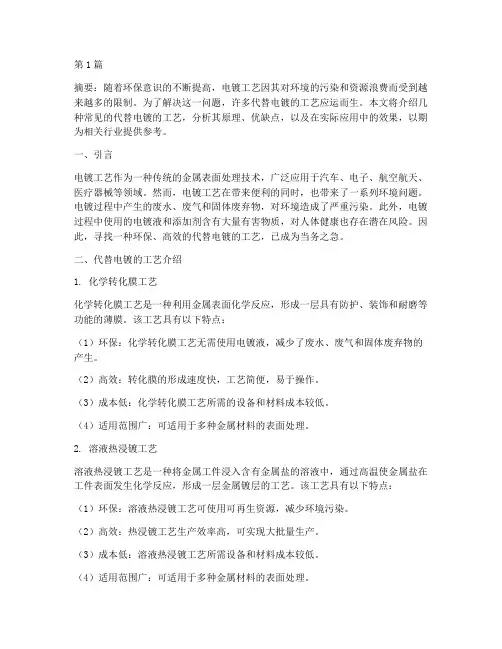
第1篇摘要:随着环保意识的不断提高,电镀工艺因其对环境的污染和资源浪费而受到越来越多的限制。
为了解决这一问题,许多代替电镀的工艺应运而生。
本文将介绍几种常见的代替电镀的工艺,分析其原理、优缺点,以及在实际应用中的效果,以期为相关行业提供参考。
一、引言电镀工艺作为一种传统的金属表面处理技术,广泛应用于汽车、电子、航空航天、医疗器械等领域。
然而,电镀工艺在带来便利的同时,也带来了一系列环境问题。
电镀过程中产生的废水、废气和固体废弃物,对环境造成了严重污染。
此外,电镀过程中使用的电镀液和添加剂含有大量有害物质,对人体健康也存在潜在风险。
因此,寻找一种环保、高效的代替电镀的工艺,已成为当务之急。
二、代替电镀的工艺介绍1. 化学转化膜工艺化学转化膜工艺是一种利用金属表面化学反应,形成一层具有防护、装饰和耐磨等功能的薄膜。
该工艺具有以下特点:(1)环保:化学转化膜工艺无需使用电镀液,减少了废水、废气和固体废弃物的产生。
(2)高效:转化膜的形成速度快,工艺简便,易于操作。
(3)成本低:化学转化膜工艺所需的设备和材料成本较低。
(4)适用范围广:可适用于多种金属材料的表面处理。
2. 溶液热浸镀工艺溶液热浸镀工艺是一种将金属工件浸入含有金属盐的溶液中,通过高温使金属盐在工件表面发生化学反应,形成一层金属镀层的工艺。
该工艺具有以下特点:(1)环保:溶液热浸镀工艺可使用可再生资源,减少环境污染。
(2)高效:热浸镀工艺生产效率高,可实现大批量生产。
(3)成本低:溶液热浸镀工艺所需设备和材料成本较低。
(4)适用范围广:可适用于多种金属材料的表面处理。
3. 激光熔覆工艺激光熔覆工艺是一种利用激光束将熔融金属或合金材料熔覆在工件表面,形成一层具有优异性能的镀层的工艺。
该工艺具有以下特点:(1)环保:激光熔覆工艺无需使用电镀液,减少了废水、废气和固体废弃物的产生。
(2)高效:激光熔覆工艺可快速实现工件表面镀层,生产效率高。
(3)成本低:激光熔覆工艺所需设备和材料成本较高,但具有较长的使用寿命。
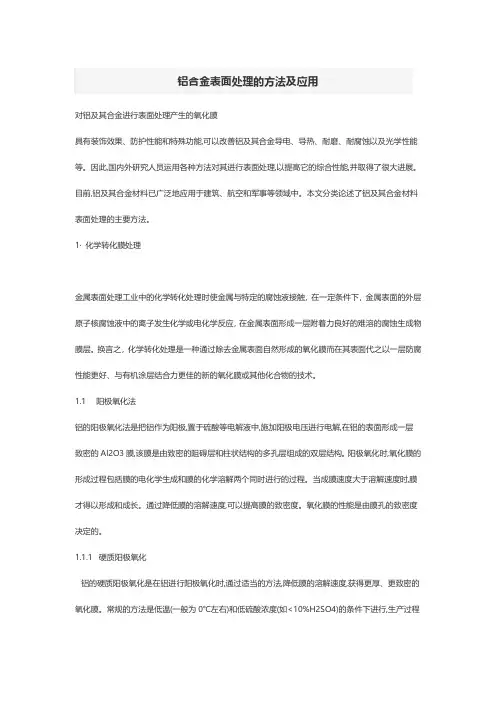
铝合金表面处理的方法及应用对铝及其合金进行表面处理产生的氧化膜具有装饰效果、防护性能和特殊功能,可以改善铝及其合金导电、导热、耐磨、耐腐蚀以及光学性能等。
因此,国内外研究人员运用各种方法对其进行表面处理,以提高它的综合性能,并取得了很大进展。
目前,铝及其合金材料已广泛地应用于建筑、航空和军事等领域中。
本文分类论述了铝及其合金材料表面处理的主要方法。
1·化学转化膜处理金属表面处理工业中的化学转化处理时使金属与特定的腐蚀液接触,在一定条件下,金属表面的外层原子核腐蚀液中的离子发生化学或电化学反应,在金属表面形成一层附着力良好的难溶的腐蚀生成物膜层。
换言之,化学转化处理是一种通过除去金属表面自然形成的氧化膜而在其表面代之以一层防腐性能更好、与有机涂层结合力更佳的新的氧化膜或其他化合物的技术。
1.1阳极氧化法铝的阳极氧化法是把铝作为阳极,置于硫酸等电解液中,施加阳极电压进行电解,在铝的表面形成一层致密的Al2O3膜,该膜是由致密的阻碍层和柱状结构的多孔层组成的双层结构。
阳极氧化时,氧化膜的形成过程包括膜的电化学生成和膜的化学溶解两个同时进行的过程。
当成膜速度大于溶解速度时,膜才得以形成和成长。
通过降低膜的溶解速度,可以提高膜的致密度。
氧化膜的性能是由膜孔的致密度决定的。
1.1.1硬质阳极氧化铝的硬质阳极氧化是在铝进行阳极氧化时,通过适当的方法,降低膜的溶解速度,获得更厚、更致密的氧化膜。
常规的方法是低温(一般为0℃左右)和低硫酸浓度(如<10%H2SO4)的条件下进行,生产过程存在能耗大、成本高的缺点。
改善硬质阳极氧化膜的另一种方法是改变电源的电流波形。
氧化膜的电阻很大,氧化过程中产生大量的热量,因此,传统直流氧化电流不宜过大,运用脉冲电流或脉冲电流与直流电流相叠加,可以极大地降低阳极氧化所需要的电压,并且可使用更高的电流密度,同时还可以通过调节占空比和峰值电压,来提高膜的生长速度,改善膜的生成质量,获得性能优良的氧化膜。
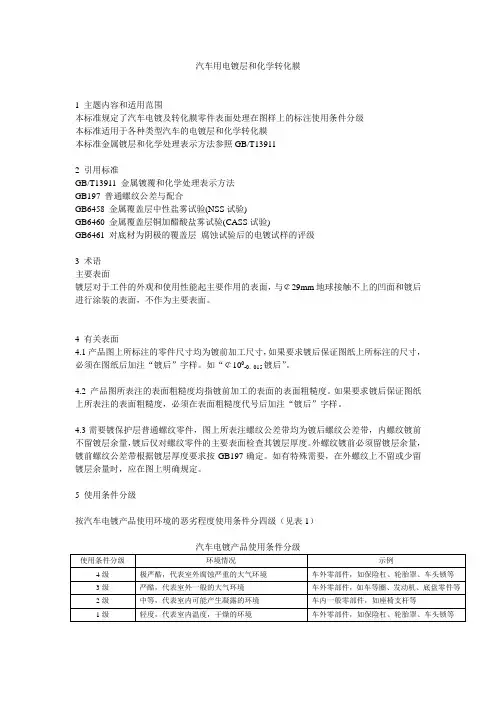
汽车用电镀层和化学转化膜1 主题内容和适用范围本标准规定了汽车电镀及转化膜零件表面处理在图样上的标注使用条件分级本标准适用于各种类型汽车的电镀层和化学转化膜本标准金属镀层和化学处理表示方法参照GB/T139112 引用标准GB/T13911 金属镀覆和化学处理表示方法GB197 普通螺纹公差与配合GB6458 金属覆盖层中性盐雾试验(NSS试验)GB6460 金属覆盖层铜加醋酸盐雾试验(CASS试验)GB6461 对底材为阴极的覆盖层腐蚀试验后的电镀试样的评级3 术语主要表面镀层对于工件的外观和使用性能起主要作用的表面,与¢29mm地球接触不上的凹面和镀后进行涂装的表面,不作为主要表面。
4 有关表面4.1产品图上所标注的零件尺寸均为镀前加工尺寸,如果要求镀后保证图纸上所标注的尺寸,必须在图纸后加注“镀后”字样。
如“¢100-0。
015镀后”。
4.2 产品图所表注的表面粗糙度均指镀前加工的表面的表面粗糙度。
如果要求镀后保证图纸上所表注的表面粗糙度,必须在表面粗糙度代号后加注“镀后”字样。
4.3需要镀保护层普通螺纹零件,图上所表注螺纹公差带均为镀后螺纹公差带,内螺纹镀前不留镀层余量,镀后仅对螺纹零件的主要表面检查其镀层厚度。
外螺纹镀前必须留镀层余量,镀前螺纹公差带根据镀层厚度要求按GB197确定。
如有特殊需要,在外螺纹上不留或少留镀层余量时,应在图上明确规定。
5 使用条件分级按汽车电镀产品使用环境的恶劣程度使用条件分四级(见表1)汽车电镀产品使用条件分级6 表面处理在图样上的标注表面处理的标注见表27 其他7.1 各种镀层的技术要求,详见每种镀层标准。
7.2 中性盐雾试验标准(NSS试验)按照GB6458标准进行。
对于镀锌层,NSS试验仅用于检查钝化膜的质量。
7.3 铜加速醋酸盐雾试验(CASS试验)应按GB6460进行。
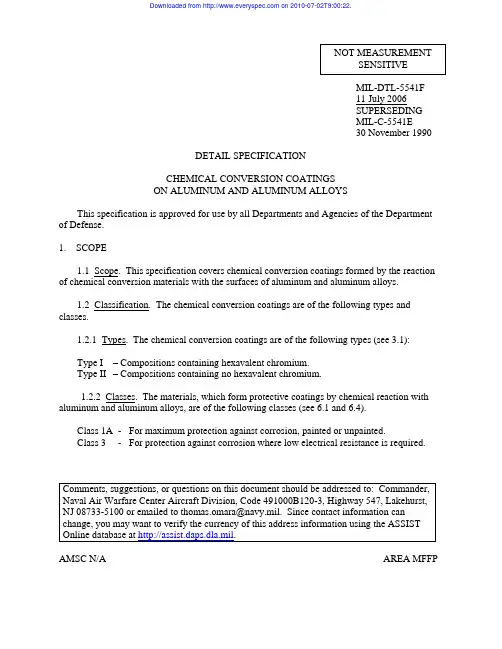
MIL-DTL-5541F11 July 2006SUPERSEDINGMIL-C-5541E30 November 1990DETAIL SPECIFICATIONCHEMICAL CONVERSION COATINGSON ALUMINUM AND ALUMINUM ALLOYSThis specification is approved for use by all Departments and Agencies of the Department of Defense.1. SCOPE1.1 Scope. This specification covers chemical conversion coatings formed by the reaction of chemical conversion materials with the surfaces of aluminum and aluminum alloys.1.2 Classification. The chemical conversion coatings are of the following types andclasses.1.2.1 Types. The chemical conversion coatings are of the following types (see 3.1):Type I – Compositions containing hexavalent chromium.Type II – Compositions containing no hexavalent chromium.1.2.2 Classes. The materials, which form protective coatings by chemical reaction withaluminum and aluminum alloys, are of the following classes (see 6.1 and 6.4).Class 1A - For maximum protection against corrosion, painted or unpainted.Class 3 - For protection against corrosion where low electrical resistance is required.Comments, suggestions, or questions on this document should be addressed to: Commander,Naval Air Warfare Center Aircraft Division, Code 491000B120-3, Highway 547, Lakehurst,NJ 08733-5100 or emailed to thomas.omara@. Since contact information canchange, you may want to verify the currency of this address information using the ASSISTOnline database at .AMSC N/A AREA MFFP2. APPLICABLE DOCUMENTS2.1 General. The documents listed in this section are specified in sections 3 or 4 of this specification. This section does not include documents cited in other sections of this specification or recommended for additional information or as examples. While every effort has been made to ensure the completeness of this list, document users are cautioned that they must meet all specified requirements of documents cited in sections 3 or 4 of this specification, whether or not they are listed.2.2 Government documents.2.2.1 Specifications and standards. The following specifications and standards form a part of this document to the extent specified herein. Unless otherwise specified, the issues of these documents are those cited in the solicitation or contract.STANDARDSFEDERALFED-STD-141 - Paint, Varnish, Lacquer and Related Materials: Methods ofInspection, Sampling and TestingDEPARTMENT OF DEFENSE SPECIFICATIONSMIL-PRF-23377 - Primer Coatings: Epoxy, High-SolidsMaterials for Coating Aluminum andConversionMIL-DTL-81706 - ChemicalAluminum AlloysMIL-PRF-85582 - Primer Coatings: Epoxy, Waterborne(Copies of these documents are available online at /quicksearch or or from the Standardization Document Order Desk, 700 Robbins Avenue, Building 4D, Philadelphia, PA 19111-5094.)2.3 Non-Government publications. The following documents form a part of this document to the extent specified herein. Unless otherwise specified, the issues of these documents are those cited in the solicitation or contract.AMERICAN SOCIETY FOR TESTING AND MATERIALS (ASTM) INTERNATIONALASTM-B117 - Salt Spray (Fog) Apparatus, Operating. (DoD adopted)ASTM-D3359 - Adhesion By Tape Test, Measuring. (DoD adopted)(Copies of these documents are available from ASTM International, 100 Barr Harbor Drive, West Conshohocken, PA 19428-2959 or .).AMERICAN SOCIETY FOR QUALITY (ASQ)ASQ-Z1.4 - Procedures, Sampling and Tables for InspectionAttributesby(Copies of this document are available from American Society for Quality, 600 North Plankinton Ave., Milwaukee, WI 53203 or .)SOCIETY OF AUTOMOTIVE ENGINEERS (SAE) INTERNATIONALSheet and Plate, 1.0Mg-0.60Si-0.28Cu-Alloy,SAE-AMS4027 - Aluminum0.20Cr, (6061; -T6 Sheet, -T651 Plate) Solution andPrecipitation Heat Treated. (DoD adopted)SAE-AMS4037 - Aluminum Alloy, Sheet and Plate, 4.4Cu-1.5Mg-0.60Mn,(2024; -T3 Flat Sheet; -T351 Plate) Solution Heat Treated.(DoD adopted)(Copies of these documents are available from SAE International, 400 Commonwealth Drive, Warrendale, PA 15096-0001 or .)2.4 Order of precedence. In the event of a conflict between the text of this document and the references cited herein, the text of this document takes precedence. Nothing in this document, however, supersedes applicable laws and regulations unless a specific exemption has been obtained.3. REQUIREMENTS3.1 Materials. If no material type is specified type I shall be used. Unless otherwise specified in the contract or order, substitutions of either type I for type II, or type II for type I coatings are not permitted. The materials used to produce a chemical conversion coating shall be approved for the selected type, class, form, and application method in accordance with the qualification requirements of MIL-DTL-81706 and shall have been accepted for listing on the applicable qualified products list (see 6.5). Replenishing chemicals, such as fluorides, added to a bath to maintain its efficiency, shall not degrade the performance of the coating being applied.3.2 Cleaning. Prior to coating, the base metal shall be mechanically or chemically cleaned such that a water break-free surface is obtained after rinsing (see 6.6). Abrasives containing iron such as steel wool, iron oxide, rouge, or steel wire are prohibited for all cleaning operations. Treated parts that have become soiled shall be cleaned with materials that will remove the soil without damaging the base metal, the part, or the conversion coating. If the coating is damaged, the damaged area shall be recleaned and recoated or the part shall be rejected.3.3Application. Unless an application method is specified in the contract or order(see 6.4), the chemical conversion coating shall be applied nonelectrolytically by spray, brush, or immersion after all heat treatments and mechanical operations such as forming, perforating, machining, brazing, and welding have been completed (see 6.11 and 6.14). Assemblies containing nonaluminum parts that may be attacked, embrittled, or damaged in any way by the conversion coating process shall not be coated as assemblies unless the nonaluminum parts are masked.3.4 Touch-up. If specified in the contract or order, mechanically damaged areas from which the coating has been removed shall be touched up or rejected. The damaged areas shall be touched up with MIL-DTL-81706 material approved on QPL-81706 for the applicable type, class, form, and method. The area to be touched up shall be not greater than 5 percent of the total item surface area (see 6.4 and 6.17).3.5 Appearance. The chemical conversion coating shall be continuous in appearance and visibly discernible in daylight. It shall be free from areas of powdery or loose coating, voids, scratches, flaws, and other defects or damages which reduce the serviceability of parts or are detrimental to the protective value and paint bonding characteristics. The size and number of contact marks shall be minimal, consistent with good practice. If specified in the contract or order, contact marks shall be touched up with MIL-DTL-81706 material approved on QPL-81706 for the applicable type, class, form, and method to prevent localized corrosion (see 6.4 and 6.8).3.6 Performance characteristics.3.6.1 Corrosion resistance. At the end of 168 hours of exposure to the 5 percent salt spray test specified in4.4.1, test specimens (see 4.2.2) treated with the applicable class of coating shall meet the following corrosion resistance requirements (see 6.14):a.No more than 5 isolated spots or pits (see 6.9), none larger than 0.031 inch in diameter,per test specimen. Areas within 0.25 inch from the edges, identification markings, andholding points during processing or salt spray exposure shall be excluded. Loss of color shall not be cause for rejection.b.No more than 15 isolated spots or pits, none larger than 0.031 inch in diameter, on thecombined surface area of all five test specimens, subjected to the salt spray test.3.6.2 Paint adhesion (wet tape). When the production paint system (6.13) or the paint system specified in4.2.2.1.1 is applied to the applicable test specimens (see 4.2.2), no intercoat separation shall occur between the paint system and the conversion coating, or between the conversion coating and the base metal, when tested in accordance with 4.4.2 (an adhesion rating of 4A or better according to ASTM-D3359 Procedure A) (see 6.12). If the conversion coated parts do not require painting for end use, the paint adhesion test may be omitted if specifically authorized by the acquisition activity (see 6.4).3.7 Electrical contact resistance of class 3 coatings. Electrical contact resistance testingshall be as specified in the contract or order (see 6.4). The test method, frequency of testing, and required resistance values shall be specified by the acquisition activity to meet the needs of aparticular application (see 6.1.2.1).3.8 Chemical analysis of the conversion solution. Chemical analysis of the conversionsolution shall consist of concentration, pH, and temperature evaluations to determine that thebath is within the ranges specified by the chemical manufacturer (see 6.11).3.9 Workmanship. The chemical conversion coatings covered by this specification shall be produced by treatments and processes that produce coated components as specified in thisspecification.4. VERIFICATION4.1 Classification of inspections. The inspection requirements specified herein areclassified as follows:a. Process control inspection (see 4.2).b. Conformance inspection (see 4.3).4.2 Process control inspection.4.2.1 Process control tests and solution analysis. Test specimens shall be tested inaccordance with table I and 4.2.1.1. In addition to the tests in table I, solution analysis shall be performed on all the processing solutions in the chemical conversion line (see 3.8) to verify that the chemical concentrations are within ranges established for optimum performance (see 6.11and 6.14). Process control tests are conducted to determine compliance of the chemicalconversion coatings with the requirements of this specification and are acceptable as evidence of the properties being obtained with the equipment and procedures employed.TABLE I. Process control tests. Tests Class Number of test specimens Test specimen preparationparagraphRequirement paragraph TestparagraphCorrosion resistance 1A 3 5 5 4.2.2 4.2.2 3.6.1 3.6.1 4.4.14.4.1Wet tape adhesion 1A 3 2 2 4.2.2-4.2.2.14.2.2-4.2.2.1 3.6.2 3.6.2 4.4.24.4.2Electrical contactresistance3 5 4.2.2 3.7 4.4.14.2.1.1 Frequency of process control testing and solution analysis. Solution analysis shall at a minimum be performed once every week (see 6.15). The process control tests specified in table I shall at a minimum be conducted on a monthly basis. In addition, the interval between each monthly test shall not exceed 35 days. If production in accordance with this specification is not performed for 35 days or more, process control tests and solution analysis shall be conducted at the restart of production.4.2.2 Process control test specimens. Test specimens used for process control testing shall be 3 inches wide, 10 inches long, with a nominal thickness of not less than 0.020-inch.The test specimens shall be processed with the hardware during an actual production run, including all pre- and post-treatment processes such as cleaning and rinsing, except as specified below. Unless otherwise specified in the contract or order (see 6.4), either of the following alloy options for the process control test specimens shall be used:Option 1 - A set of test specimens shall be used for each alloy and temper treated during the monthly process control period.Option 2 - The test specimens shall be 2024-T3 aluminum alloy in accordance withSAE-AMS4037 for class 1A coatings and 6061-T6 aluminum alloy test specimens in accordance with SAE-AMS4027 for class 3 coatings. Aluminum alloy 2024-T3 test specimens may be used in lieu of 6061-T6 test specimens for testing class 3 coatings (see 6.10). When castings are being processed and the cleaning procedures used are detrimental to the wrought test specimens, the test specimens shall be cleaned in a proper manner (see 3.2) and the conversion coated with the castings. If the production parts are not 2024-T3 aluminum alloy and the etch or deoxidizer may be detrimental to the test specimens, the manufacturer’s recommended cleaning practices shall be used.4.2.2.1 Preparation of paint adhesion specimens. Unless otherwise specified on the contract or order (see 6.4), the paint system to be used on the test specimens for adhesion testing (see4.4.2 and 6.13) shall be the same system used for the production work (applied and cured in the same manner as the production work) or the paint system specified in 4.2.2.1.1.4.2.2.1.1 Epoxy primer coatings. Test specimens shall be furnished with one coat of a volatile organic compound (VOC) compliant epoxy-polymide primer conforming toMIL-PRF-23377 or MIL-PRF-85582. In either case, the primer shall be applied to a dry film thickness of 0.0006 to 0.0009 inch (0.6 to 0.9 mil) and dried in accordance with the applicable primer specification before testing in accordance with 4.4.2.4.2.3 Failure. Failure to conform to any of the process control requirements specified in table I shall result in immediate cessation of production. The reason for failure shall be determined and corrected before production resumes. All traceable and retrievable work from the last acceptable process control test to the time when the failure was determined shall be rejected, unless the work under review can be demonstrated to meet the requirements of thisspecification. Unless otherwise specified, parts that have been painted or incorporated into an assembly shall not be considered retrievable.4.3 Conformance inspection.4.3.1 Sampling. Samples for visual examinations shall be selected from each lot (see 4.3.2) of treated articles, items, parts, or components. Unless otherwise specified in the contract or order (see 6.4 and 6.18), the sampling plan and acceptance criteria shall be as specified in ASQ-Z1.4, inspection level II.4.3.2 Visual lot examination. Samples selected in accordance with 4.3.1 shall be visually inspected for compliance with 3.5 and 3.9. Each lot shall be inspected to ensure that the lot consists of all conversion coated items of the same type, class, form, and method, treated under the same process conditions, and submitted for acceptance at one time. Unless otherwise specified on the contract or order, the lot size shall not exceed the number of parts, articles, items, or components resulting from one day’s production (see 6.4).4.3.3 Failure. Failure to conform to 4.3.2 shall result in rejection of the represented lot.4.4.Test methods.4.4.1 Corrosion resistance test. Five test specimens prepared in accordance with 4.2.2 shall be used for corrosion resistance testing. After the coating application, the test specimens shall be dried at 60 to 100 ºF (16 to 38 ºC) for 24 hours (see 6.14). The test specimens shall then be subjected to a 5 percent salt spray test in accordance with ASTM-B117 for 168 hours, except that the significant surface shall be inclined 6 ± 2 degrees from the vertical. After exposure, test pieces shall be cleaned in running water not warmer than 100 ºF (38 ºC), blown with clean, dry unheated air, and visually examined for conformance to 3.6.1. The dry unheated air for type I shall be not warmer than 100 ºF (38 ºC) and for type II shall follow the manufacturer’s recommended temperature ranges.4.4.2 Wet tape adhesion test. Two test specimens prepared in accordance with 4.2.2 and 4.2.2.1 shall be tested for wet tape adhesion. The test shall be conducted in accordance with FED-STD-141, method 6301, to determine conformance to 3.6.2.5. PACKAGING5.1 Not applicable.6. NOTES(This section contains information of a general or explanatory nature that may be helpful, but is not mandatory.)6.1 Intended use. The conversion coatings covered by this specification are intended for use, throughout the Department of Defense, on aluminum and aluminum alloy substrates that are not anodized. They are used to repair anodized coatings on aluminum. They are designated as a post treatment to ion-vapor deposition (IVD) aluminum used on many military platforms as a cadmium alternative or galvanic corrosion inhibitor. Type I and II conversion coatings provide corrosion protection on unpainted items, as well as improve adhesion of paint finish systems on aluminum and aluminum alloys. The conversion coatings covered by this specification exceed commercially available products due to the nature of their use on aircraft.6.1.1 Class 1A. Class 1A chemical conversion coatings are intended to provide corrosion prevention on unpainted items as well as improve adhesion of paint finish systems on aluminum and aluminum alloys. Coatings of this type may be used, for example, on tanks, tubing, and component structures where paint finishes are not required for interior surfaces but are required for the exterior surfaces.6.1.2 Class 3. Class 3 chemical conversion coatings are intended for use as a corrosion preventive film for electrical and electronic applications where lower resistant contacts, relative to class 1A coatings, and anodic coatings in accordance with MIL-A-8625, are required (see 6.1.2.1). Coating thickness is varied by immersion time, and as a result, the same conversion material can be listed on QPL-81706 for both classes. Because class 3 coatings are thinner they are more susceptible to corrosion than class 1A coatings. If it is required to paint areas surrounding electrical contacts, class 3 coatings improve adhesion of paint systems on aluminum and aluminum alloys.6.1.2.1 Electrical resistance testing. When under a nominal electrode pressure of 200 psi, class 3 coatings are qualified under MIL-DTL-81706 to have a resistance not greater than 5,000 microhms per square inch as supplied and 10,000 microhms per square inch after 168 hours of salt spray exposure. In addition to the coating or coating thickness (see 6.1.2), other variables heavily influence resistance values when using the test method specified in MIL-DTL-81706 or other similar methods. The following two variables (see 6.1.2.1.1 and 6.1.2.1.2) may have a greater effect on electrical resistance values than the conversion coating thickness.6.1.2.1.1 Surface roughness of the specimen panel. Test specimens having rough surfaces will yield lower resistance values when subjected to a contact electrode pressure due to coating fracture. This reasoning can also be applied to the contact electrode.6.1.2.1.2 Flatness of the contact electrode. If an electrode with a given surface area is not flat, the actual contact area will be lower than the theoretical value. A smaller contact arearesults in a higher resistance value. The same reasoning can be applied to the test specimen.6.2 Responsibility for inspection. Unless otherwise specified in the contract or order, the contractor is responsible for the performance of all inspection requirements (examinations and tests) as specified herein. Except as otherwise specified in the contract or order, the contractor may use his own or any other facilities suitable for the performance of the inspection requirements specified herein, unless disapproved by the Government. The Government reserves the right to perform any of the inspections set forth in the specification where such inspections are deemed necessary to ensure supplies and services conform to prescribed requirements.6.3 Responsibility for compliance. All items must meet the requirements of section 3. The inspection set forth in this specification must become a part of the contractor’s overall inspection system or quality program. The absence of any inspection requirement in the specification will not relieve the contractor of the responsibility of ensuring that all products or supplies submitted to the Government for acceptance comply with all requirements of the contract. Sampling inspection, as part of manufacturing operations, is an acceptable practice to ascertain conformance to requirements, however, this does not authorize submission of known defective material, either indicated or actual, nor does it commit the Government to acceptance of defective material.6.4 Acquisition requirements. Acquisition documents should specify the following:a. Title, number, and date of the specification.b. Type and class required (see 1.2.1 and 1.2.2).c.Method of application, if restricted (see 3.3).d. If touch-up is permitted for mechanically damaged areas (see 3.4).e.Colorless coatings, if required (see 3.5).f. If touch-up is permitted for contact marks (see 3.5)g.Omit the paint adhesion test, if permitted (see 3.6.2).h.If electrical resistance testing if required for class 3 coatings (see 3.7 and 6.1.2).i.When electrical resistance testing is required, specify the required resistance values,frequency of testing, and test method (see 3.7 and 6.1.2).j.Alloy and temper of the process control test specimens, if different than that specified in4.2.2.k.Paint finish system for treated parts, if applicable (see 4.2.2.1).l.Quantity required.m. Sampling plan, if different than that specified (see 4.3.1 and 6.18).n. Lot size, if different than that specified (see 4.3.2).6.5 Interchangeability. The various products approved in accordance withMIL-DTL-81706 and listed on QPL-81706 provide equivalent coatings within eachtype and class. These coatings are equivalent insofar as performance of the chemical conversion coating is concerned, to the provisions of this specification, but are not interchangeable from a chemical standpoint; that is, different materials cannot be mixed. The materials from onesupplier cannot be mixed or used to strengthen an existing solution from another material supplier. As the chemical coating materials are proprietary products, the ingredients, processes, the method of application (e.g., spray, brush, or immersion), and the equipment required for application of the coating may vary. Contractors and military activities must take this into account in acquisition, in the design of parts, and in the establishment of facilities. Detail drawing of parts requiring treatment in accordance with this specification should specify class1A or 3, where applicable the required type, I or II, and any paint finishing systems required to meet the performance desired. If the coating class is not specified, class 1A is recommended.6.6 Cleaners. Use of a non-etch cleaner is preferred, particularly on wrought alloys. If an etch is used, caution must be taken to prevent pitting or intergranular attack. This is particularly important when using an alkaline etch because the aluminum tends to be more soluble than its alloying elements and existing intermetallics, such as copper, which may be further exposed. As a result, alkaline etching should be avoided (particularly when cleaning assembled structures). If an alkaline etch is used, it should always be followed by an acid neutralization step.6.7 Abrasion resistance. The abrasion resistance of chemical coatings is relatively low. Coatings are reasonably durable when subjected only to moderate handling, but are readily removed by severe wear or erosion. However, cold forming operations, when performed with care, can generally be performed on treated metals without appreciable damage to the coatings.6.8 Visual appearance. The simplest way to evaluate a conversion coating is to observe color, continuity in appearance, smoothness and adhesion to the base metal (see 3.5). Visual examination is performed to ensure that proper cleaning and coating procedures were used such that a coating with sufficient protection exists over the entire part. Materials qualified underMIL-DTL-81706 produce coatings that range in color from clear/colorless to iridescent yellow, brown, gray, or blue. It may be possible to develop acceptable color levels for a particular coating system by use of color chips. The following circumstances may exist that relate to color uniformity:a.When several alloys are processed with the same conversion chemical, color may varyfrom alloy to alloy.b.Due to the high level of impurities and oxidation on the surfaces of aluminum welds andcastings, color may not be as uniform as that obtained by treating wrought alloys.c.Dark spots may result from dripping or rundown of the conversion chemicals when theparts are lifted out of the treatment tank. A small amount of spotting does not result incoating degradation but must be minimized by quickly rinsing the parts after treatment, and use of proper racking techniques.Visual examination does not reveal if the protective value of the coating has been impaired by contamination or by overheating during drying. If a clear coating is required, inspection difficulties may arise because visual inspection does not reveal the presence of a coating. Fortype I materials, existence of a coating can be verified by using a simple spot test specified in ASTM-B449. For type II materials, existence of a coating should be verified per the manufacturer’s recommendation6.9 Determination of a corrosion spot or pit. As a general rule, a corrosion spot or pit usually displays a characteristic tail or line, however, any visible corrosion or pitting except scratches or substrate surface defects is to be counted..6.10 Test specimens (2024-T3). Due to high copper content, 2024-T3 aluminum alloy test specimens are more susceptible to salt spray failure than 6061-T6 aluminum alloy test specimens (see 4.2.2).6.11 Chemical analysis of the conversion solution. Note that many conversion materials do not react sufficiently with aluminum surfaces at low temperatures. Conversion coating of parts in an unheated facility, such as a hangar, during colder periods of the year is not recommended.6.12 Paint adhesion. Coated parts should be allowed to dry in accordance with the chemical manufacturer’s recommendation before they are subsequently painted or adhesion failures may occur. When coated parts are stored for extensive periods before painting, they should be cleaned in accordance with 3.2 to reactivate the surface by removing dust particles. Excessively thick coatings may result in paint adhesion problems, such as blistering, due to higher amounts of soluble material under the paint.6.13 Paint compatibility. Compatibility problems between conversion coatings and certain Chemical Agent Resistant Coatings (CARC) have been reported.6.14 Temperature effects on corrosion protection. Unpainted conversion coatings will commence losing corrosion resistance properties if exposed to temperatures of 140 ºF (60 ºC) or higher, during drying, subsequent fabrication, or service. As temperatures and exposure times increase, the corrosion protection of unpainted conversion coated parts decreases. The reduction is believed to result from the coating dehydrating and the resulting insolubility of the chromates within the coating.6.15 Solution analysis documentation. Documentation of the history of each processing bath, showing additions of replenishing chemicals to the bath and the results of all solution analyses performed must be maintained. Testing of the solution should be consistent with best industry practices and manufacturer’s recommendations. Upon request of the acquisition activity, such records, as well as reports of the test results, should be made available. These records must be maintained for not less than one year after completion of the contract or order.6.16 Shelf life. This specification covers items where shelf life is a consideration. Specific shelf-life requirements should be specified in the contract or purchase order. The shelf-life codes are contained in the Federal Logistics Information System Total Item Record. Additive information for shelf-life management may be obtained from DoD 4140.27-M, Shelf-life。
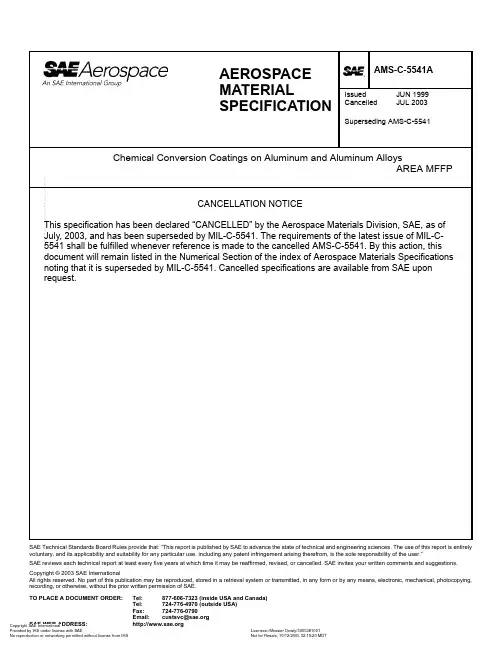
SAE Technical Standards Board Rules provide that: “This report is published by SAE to advance the state of technical and engineering sciences. The use of this report is entirely voluntary, and its applicability and suitability for any particular use, including any patent infringement arising therefrom, is the sole responsibility of the user.”SAE reviews each technical report at least every five years at which time it may be reaffirmed, revised, or cancelled. SAE invites your written comments and suggestions.Copyright © 2003 SAE InternationalAll rights reserved. No part of this publication may be reproduced, stored in a retrieval system or transmitted, in any form or by any means, electronic, mechanical, photocopying,recording, or otherwise, without the prior written permission of SAE.TO PLACE A DOCUMENT ORDER:Tel: 877-606-7323 (inside USA and Canada)Tel: 724-776-4970 (outside USA)Chemical Conversion Coatings on Aluminum and Aluminum AlloysAREA MFFP CANCELLATION NOTICEThis specification has been declared “CANCELLED” by the Aerospace Materials Division, SAE, as of July, 2003, and has been superseded by MIL-C-5541. The requirements of the latest issue of MIL-C-5541 shall be fulfilled whenever reference is made to the cancelled AMS-C-5541. By this action, this document will remain listed in the Numerical Section of the index of Aerospace Materials Specifications noting that it is superseded by MIL-C-5541. Cancelled specifications are available from SAE upon request.AEROSPACEMATERIALSPECIFICATION AMS-C-5541A IssuedJUN 1999Cancelled JUL 2003Superseding AMS-C-5541--``,,``,`````,```,,,`,```,,,``-`-`,,`,,`,`,,`---NOTICEThis document has been taken directly from U.S. Military Specification MIL-C-5541E and contains only minor editorial and format changes required to bring it into conformance with the publishing requirements of SAE technical standards. The initial release of this document is intended to replace MIL-C-5541E. Any part numbers established by the original specification remain unchanged.The original Military Specification was adopted as an SAE standard under the provisions of the SAE Technical Standards Board (TSB) Rules and Regulations (TSB 001) pertaining to accelerated adoption of government specifications and standards. TSB rules provide for (a) the publication of portions of --``,,``,`````,```,,,`,```,,,``-`-`,,`,,`,`,,`---unrevised government specifications and standards without consensus voting at the SAE Committee level, and (b) the use of the existing government specification or standard format.Under Department of Defense policies and procedures, any qualification requirements and associated qualified products lists are mandatory for DOD contracts. Any requirement relating to qualified products lists (QPL’s) has not been adopted by SAE and is not part of this SAE technical document.1.SCOPE:1.1Scope:This specification covers the requirements for two classes of chemical conversion coatings formed by the reaction of chemical conversion materials and the surfaces of aluminum and aluminum alloys.This specification is intended specifically to provide components of military weapon systems with maximum corrosion resistance. The coating also provides a surface having better paint adhesion than uncoated aluminum. It is not intended as a general purpose coating for commercial anddecorative applications, (see 6.1).1.2Classification:The chemical conversion coatings shall be of the following classes, as specified (see 6.2).1.2.1Classes:Class 1 A - For maximum protection against corrosion, for surfaces to be painted or left unpainted, (see 6.1.1).Class 3 - For protection against corrosion where lower electrical resistance is required, (see 6.1.2).2.APPLICABLE DOCUMENTS:The following publications, of the issue in effect on date of invitation for bids or request for proposal, form a part of this specification to the extent specified herein.2.1U.S. Government Publications:Available from DODSSP, Subscription Services Desk, Building 4D, 700 Robbins Avenue,Philadelphia, PA 19111-5094.QQ-A-250/4Aluminum Alloy 2024, Plate and SheetQQ-A-250/11Aluminum Alloy 6061, Plate and SheetMIL-P-23377Primer Coating, Epoxy Polyamide, Chemical and Solvent ResistantMIL-C-81706Chemical Conversion Materials For Coating Aluminum and Aluminum AlloysMIL-P-85582Primer Coatings: Epoxy, WaterborneFED-STD-141Paint, Varnish, Lacquer and Related Materials, Methods of Inspection, Sampling and TestingMIL-STD-105Sampling Procedures and Tables for Inspection by Attributes2.2ASTM Publications:Available from ASTM, 100 Barr Harbor Drive, West Conshohocken, PA 19428-2959.ASTM B 117Salt Spray (Fog) Testing2.3Order of precedence:In the event of a conflict between the text of this document and the references cited herein, the text of this document takes precedence. Nothing in this document, however, supersedes applicable lawsand regulations unless a specific exemption has been obtained.3.REQUIREMENTS:3.1Chemical conversion materials:The materials used to produce a chemical conversion coating shall be approved for the selected class, form and application method in accordance with the qualification requirements ofMIL-C-81706 and been accepted for listing on the applicable Qualified Products List (see 6.3).Replenishing chemicals, such as fluorides, added to a bath to maintain its efficiency, shall in no way degrade the performance of the coating being applied.3.2Cleaning:Prior to coating, the base metal shall be mechanically and/or chemically cleaned such that a water break-free surface is obtained after rinsing (see 6.4). Abrasives containing iron such as steel wool, iron oxide, rouge or steel wire are prohibited for all cleaning operations as particles from them may become embedded in the metal and accelerate corrosion of the aluminum and aluminum alloys.Treated parts which have become soiled shall be cleaned with materials which will remove the soil without damaging the base metal, the part, or the conversion coating. If the coating is damaged, the damaged area shall be recleaned and recoated or the part shall be rejected.3.3Application:Unless an application method is specified, the chemical conversion materials shall be appliednonelectrolytically by spray, brush or immersion after all heat treatments and mechanical operations such as forming, perforating, machining, brazing and welding have been completed. Assemblies containing non-aluminum parts which may be attacked, embrittled, or damaged in any way by the conversion coating process shall not be coated as assemblies unless the non-aluminum parts are suitably masked.--` ` , , ` ` , ` ` ` ` ` , ` ` ` , , , ` , ` ` ` , , , ` ` -` -` , , ` , , ` , ` , , ` ---3.4Rework:Unless otherwise specified by the procuring activity, mechanically damaged areas from which the coating has been removed may be reworked. The damaged areas shall be touched up withMIL-C-81706 material approved on the QPL for the applicable class and method of application. The rework area shall not exceed 5 percent of total item surface area. If the area exceeds 5 percent, specific approval must be obtained from the procuring activity before the area can be reworked.3.5Appearance:The conversion coating shall be as uniform in appearance as practical (see 6.6). It shall becontinuous and free from areas of powdery or loose coating, voids, scratches, flaws and otherdefects or damages which will reduce the serviceability of parts or be detrimental to the protective value and paint bonding characteristics. The size and number of contact marks shall be at aminimum, consistent with good practice. If specified, contact marks shall be touched up withMIL-C-81706 material approved on the QPL for the applicable class and method of application to prevent localized corrosion. Clear (colorless) coating shall only be used when specifically authorized by the procuring activity, (see 6.2 and 6.6).3.6Corrosion resistance properties:At the end of 168 hours exposure to the 5 percent salt spray test specified in 4.5.1, specimen panels (see 4.3.3) treated with the applicable class of coating shall meet all of the following corrosionresistance requirements:a.No more than 5 isolated spots or pits (see 6.7), none larger than 0.031 inches in diameter, perspecimen panel. Areas within 0.25 inches from the edges, identification markings, and holding points during processing or salt spray exposure shall be excluded. Loss of color shall not because for rejection.b.No more than 15 isolated spots or pits, none larger than .031 inches in diameter, on thecombined surface area of all five specimen panels, subjected to the salt spray test.3.7Paint adhesion properties:When the production paint system or the paint system specified in 4.3.3.1.1 is applied to theapplicable specimen panels (see 4.3.3), no intercoat separation shall occur between the paintsystem and the conversion coating or between the conversion coating and the base metal when tested in accordance with 4.5.2, (see 6.10). If the conversion coated parts do not require painting for end use, the paint adhesion test may be omitted if specifically authorized by the procuring activity (see 6.2).--` ` , , ` ` , ` ` ` ` ` , ` ` ` , , , ` , ` ` ` , , , ` ` -` -` , , ` , , ` , ` , , ` ---3.8Electrical contact resistance of Class 3 coatings:If specified (see 6.2), electrical contact resistance testing shall be performed. The test method, frequency of testing, and required resistance values shall be specified by the procuring activity to suit the needs of a particular application.3.9Workmanship:The chemical coatings covered by this specification shall be produced by suitable treatments and processes to give uniformly coated products as specified herein.4.QUALITY ASSURANCE PROVISIONS:4.1Responsibility for inspection:Unless otherwise specified in the contract or purchase order, the contractor is responsible for the performance of all inspection requirements (examinations and tests) as specified herein. Except as otherwise specified in the contract or purchase order, the contractor may use his own or any other facilities suitable for the performance of the inspection requirements specified herein, unlessdisapproved by the Government. The Government reserves the right to perform any of theinspections set forth in the specification where such inspections are deemed necessary to ensure supplies and services conform to prescribed requirements.4.1.1Responsibility for compliance: All items must meet all requirements of Section 3. The inspectionset forth in this specification shall become a part of the contractor’s overall inspection system or quality program. The absence of any inspection requirements in the specification shall not relieve the contractor of the responsibility of ensuring that all products or supplies submitted to theGovernment for acceptance comply with all requirements of the contract. Sampling inspection, as part of manufacturing operations, is an acceptable practice to ascertain conformance torequirements, however, this does not authorize submission of known defective material, eitherindicated or actual, nor does it commit the Government to acceptance of defective material.4.2Classification of inspection:--``,,``,`````,```,,,`,```,,,``-`-`,,`,,`,`,,`---The inspection requirements specified herein are classified as follows:a.Process control inspection (see 4.3).b.Quality conformance inspection (see 4.4).4.3Process control inspection:4.3.1Process control tests and solution analysis: To assure continuous control of the process, testspecimens (see 4.3.3) shall be tested in accordance with Table I (see 4.3.1.1). In addition to the tests in Table I, solution analysis shall be performed on all the processing solutions in theconversion coating line (see 6.9) to verify that the chemical concentrations are within rangesestablished for optimum performance (see 4.3.1.1 and 4.3.2). Process control tests are conducted to determine compliance of the chemical conversion coatings with the requirements of thisspecification and are acceptable as evidence of the properties being obtained with the equipment and procedures employed.Table I. Process control tests.4.3.1.1Frequency of process control testing and solution analysis: Solution analysis shall be performedonce every week. The process control tests specified in Table I shall be conducted on a monthly basis. In addition, the interval between each monthly test shall not exceed 35 days. If production in accordance with this specification is not performed for a period of 35 days or longer, process control tests and solution analysis shall be conducted at the restart of production.4.3.2Solution analysis records: The processor shall maintain a record of the history of each processingbath, showing additions of replenishing chemicals to the bath and the results of all solutionanalyses performed. Upon request of the procuring activity, such records, as well as reports of the test results, shall be made available. These records shall be maintained for not less than one year after completion of the contract or purchase order.--` ` , , ` ` , ` ` ` ` ` , ` ` ` , , , ` , ` ` ` , , , ` ` -` -` , , ` , , ` , ` , , ` ---4.3.3Process control specimen panels: Specimen panels used for process control testing shall be3inches in width, 10 inches in length, with a minimum 0.020 inch nominal thickness. Thespecimen panels shall be processed with the hardware during an actual production run, including all pre- and post-treatment processes such as cleaning and rinsing, except as specified below.Unless otherwise specified in the contract or order (see 6.2), either of the following alloy options for the process control specimen panels may be utilized:Option 1 - A set of specimen panels shall be used for each alloy and temper treated during themonthly process control period.Option 2 - The specimen panels shall be 2024-T3 aluminum alloy panels per QQ-A-250/4 for class 1A coatings and 6061-T6 aluminum alloy panels per QQ-A-250/11 for class 3 coatings. If desired, 2024-T3 panels may be used in lieu of 6061-T6 panels for testing class 3 coatings (see 6.8). When castings are being processed and the cleaning procedures used are detrimental to the wrought --``,,``,`````,```,,,`,```,,,``-`-`,,`,,`,`,,`---specimen panels, the panels shall be cleaned in an appropriate manner (see 3.2) and conversion coated with the castings.4.3.3.1Preparation of paint adhesion specimens: Unless otherwise specified (see 6.2), the paint systemto be used on the specimen panels for adhesion testing (see 4.5.2) shall be that used for theproduction work (applied and cured in the same manner as the production work) or the paintsystem specified in 4.3.3.1.1.4.3.3.1.1Epoxy primer coatings: Specimen panels shall be finished with one coat of a (VOC) compliantepoxy-polyamide primer conforming to either MIL-P-23377 or MIL-P-85582. In either case theprimer shall be applied to a dry film thickness of 0.0006 to 0.0009 inch (0.6 to 0.9 mil) and driedin accordance with the applicable primer specification before testing in accordance with 4.5.2.4.3.4Failure: Failure to conform to any of the process control requirements specified in Table I shallresult in immediate halt of production. The reason for failure shall be determined and corrected before production resumes. All traceable and retrievable work from the time the failed processcontrol specimens were conversion coated to the time when the failure was determined shall be rejected, unless the contractor can demonstrate that the items under review can meet therequirements of this specification. Unless otherwise specified, parts which have been painted or incorporated into an assembly shall not be considered retrievable.4.4Quality conformance (lot acceptance) inspection:4.4.1Lot: A lot shall consist of all conversion coated items of the same class, treated under the sameconditions, and submitted for acceptance at one time. Unless otherwise specified, the lot size shall not exceed the number of parts, articles, items or components resulting from a one day’sproduction (see 6.2).4.4.2Sampling plan and acceptance criteria: Samples for visual examinations shall be selected fromeach lot of treated articles, items, parts or components. Unless otherwise specified in the contract or order (see 6.2), the sampling plan and acceptance criteria shall be as specified in inspection level II of MIL-STD-105 with an AQL of 1.5 percent defective.4.4.3Visual lot examination: Samples selected in accordance with 4.4.2 shall be visually inspected forcompliance with the requirements of 3.5 and 3.9.4.4.4Failure: Failure to conform to any of the quality conformance requirements shall result in rejectionof the represented lot.4.5Test methods:4.5.1Corrosion resistance test: Five specimen panels prepared in accordance with paragraph 4.3.3shall be used for corrosion resistance testing. After the coating application, the specimen panels shall be dried at 60-100°F for 24 hours. The panels shall then be subjected to a 5 percent saltspray test in accordance with ASTM B117 for 168 hours, except that the significant surface shall be inclined 6 degrees from the vertical. After exposure, test pieces shall be cleaned in running water, not warmer than 38°C (100°F), blown with clean, dry unheated air, and visually examined forconformance with paragraph 3.6.4.5.2Wet tape adhesion test: Two specimen panels prepared in accordance with 4.3.3 and 4.3.3.1 shall --``,,``,`````,```,,,`,```,,,``-`-`,,`,,`,`,,`---be tested for wet tape adhesion. The test shall be conducted as described in method 6301 ofFED-STD-141 to determine conformance with paragraph 3.7.5.PACKAGING:5.1The requirements of Section 5 are not applicable.6.NOTES:(This section contains information of a general or explanatory nature that may be helpful, but is not mandatory.)6.1Intended use:6.1.1Class 1A: Class 1A chemical conversion coatings are intended to provide corrosion preventionwhen left unpainted as well as to improve adhesion of paint finish systems on aluminum andaluminum alloys. Coatings of this type may be used, for example, on tanks, tubing, andcomponent structures where paint finishes are not required for the interior surfaces but arerequired for the exterior surfaces.6.1.2Class 3: Class 3 chemical conversion coatings are intended for use as a corrosion preventive filmfor electrical and electronic applications where lower resistant contacts, relative to Class 1Acoatings, and anodic coatings in accordance with MIL-A-8625, are required (see 6.1.2.1). Theprimary difference between a Class 1A and Class 3 coating is thickness, since current passesmore readily through a thinner current resistant barrier (coating). Coating thickness is varied by immersion time, and as a result, the same conversion material can be listed on QPL-81706 for both classes. Because Class 3 coatings are thinner, they are more susceptible to corrosion than Class 1A coatings. If it is required to paint areas surrounding electrical contacts, Class 3 coatings will improve adhesion of paint systems on aluminum and aluminum alloys.6.1.2.1Electrical resistance testing: When under a nominal electrode pressure of 200 psi, Class 3coatings are qualified per MIL-C-81706 to have a resistance no greater than 5,000 microhms per square inch as supplied and 10,000 microhms per square inch after 168 hours of salt sprayexposure. In addition to the coating or coating thickness (see 6.1.2), other variables heavilyinfluence resistance values when using the test method specified in MIL-C-81706 or other similar methods. The following two variables may have a greater effect on electrical resistance values than the conversion coating thickness.6.1.2.1.1Surface roughness of the specimen panel: Panels having rough surfaces will yield lowerresistance values when subjected to a contact electrode pressure due to coating fracture. Thisreasoning can also be applied to the contact electrode.6.1.2.1.2Flatness of the contact electrode: If an electrode with a given surface area is not flat, the actualcontact area will be lower than the theoretical value. Smaller contact area will result in a higherresistance value. The same reasoning can be applied to the specimen panel.6.2Ordering data:Acquisition documents should specify the following:a.Title, number and date of this specification.b.Class of coating (see 1.2.1).c.Method of application, if restricted (see 3.3).d.Clear coatings, if desired (see 3.5).--``,,``,`````,```,,,`,```,,,``-`-`,,`,,`,`,,`---e.Omit the paint adhesion test, if permitted (see 3.7)f.If electrical resistance testing is required for Class 3 coatings, (see 3.8 and 6.1.2).g.When electrical resistance testing is required, specify the required resistance values, frequencyof testing, and test method (see 3.8 and 6.1.2).h.Alloy and temper of the process control specimen panels, if different than that specified in 4.3.3.i.Paint finish system for treated parts, if applicable (see 4.3.3.1)j.Lot size, if different from that specified (see 4.4.1).k.Sampling plan, if different from that specified (see 4.4.2).6.3Interchangeability:The various products approved in accordance with MIL-C-81706 and listed on QPL-81706 willprovide equivalent coatings within each class insofar as performance of the chemical conversion coating is concerned to the provisions of the document, but are not interchangeable from a chemical standpoint; that is, different materials can not be mixed. The materials from one supplier shall not be mixed or used to strengthen an existing solution from another material supplier. As the chemical coating materials are proprietary products, the ingredients, processes, the method of application (spray, brush, or immersion), and the equipment required for application of coating may vary.Coating contractors and military activities should take this into account in acquisition, in the design of parts and the establishment of facilities. Detail drawing of parts requiring treatment in accordance with this specification should specify the Class 1A or 3 and any paint finishing systems required to meet the performance desired. If the coating class is not specified, Class 1A is recommended.6.4Cleaners:Use of a non-etch cleaner is preferred, particularly on wrought alloys. If an etch is used, caution should be taken to prevent pitting or intergranular attack. This is particularly important when using an alkaline etch because the aluminum tends to be more soluble than its alloying elements and existing intermetallics, such as copper, may be further exposed. As a result, alkaline etching should be avoided (particularly when cleaning assembled structures). If an alkaline etch is used, it should always be followed by an acid neutralization step.6.5Abrasion resistance:The abrasion resistance of chemical coatings is relatively low. Coatings are reasonably durable when subjected only to moderate handling, but are readily removed by severe wear or erosion.However, cold forming operations, when performed with care, can generally be performed on treated metals without appreciable damage to the coatings.6.6Visual appearance:--``,,``,`````,```,,,`,```,,,``-`-`,,`,,`,`,,`---The simplest way to evaluate a conversion coating is to observe color, uniformity of appearance, smoothness and adhesion to the base metal (see 3.5). Visual examination is performed to assure that proper cleaning and coating procedures were used such that a coating with sufficient protection exists over the entire part. Materials qualified under MIL-C-81706 produce coatings that range in color from clear to iridescent yellow or brown. It may be possible to develop acceptable color levels for a particular coating system by use of color chips. The following circumstances may exist which relate to color uniformity:6.6 (Continued):a.When several alloys are processed with the same conversion chemical, color may vary fromalloy to alloy.b.Due to the high level of impurities and oxidation on the surfaces of aluminum welds and castings,color may not be as uniform as that obtained by treating wrought alloys.c.Dark spots may result from dripping or rundown of the conversion chemicals when the parts arelifted out of the treatment tank. A small amount of spotting will not result in coating degradation but should be minimized by quickly rinsing the parts after treatment, and use of proper racking --``,,``,`````,```,,,`,```,,,``-`-`,,`,,`,`,,`---techniques.Visual examination will not reveal if the protective value of the coating has been impaired bycontamination or by overheating during drying. If a clear coating is required, inspection difficulties may arise because visual inspection does not reveal the presence of a coating. The existence of a coating can be verified by using a simple spot test specified in ASTM B 449.6.7Determination of a corrosion spot or pit:As a general rule, a corrosion spot or pit usually displays a characteristic tail or line (see 3.6).6.8Specimen panels (2024-T3):Due to high copper content, 2024-T3 aluminum alloy panels are more susceptible to salt sprayfailure than 6061-T6 aluminum alloy panels (see 4.3.3).6.9Chemical analysis of the conversion solution:As a minimum, chemical analysis of the conversion solution should consist of concentration, pH, and temperature evaluations to determine that the bath is within the ranges specified by the chemical manufacturer. It should be noted that many conversion materials do not react sufficiently withaluminum surfaces at low temperatures. Conversion coating parts in an unheated facility (ie. a hangar) during colder periods of the year would not be recommended.6.10Paint adhesion:Coated parts should be allowed to dry in accordance with the chemical manufacturer’srecommendation before they are subsequently painted or adhesion failures may occur. Whencoated parts are stored for extensive periods before painting, they should be cleaned in accordance with 3.2 to reactivate the surface by removing dust particles. Excessively thick coatings may result in paint adhesion problems (blistering) due to higher amounts of soluble material under the paint.6.10.1Paint compatibility: Compatibility problems between conversion coatings and certain ChemicalAgent Resistant Coatings (CARC) have been reported.6.11Temperature effects on corrosion protection:Unpainted conversion coatings will commence losing corrosion resistance properties if exposed to temperatures of 60°C (140°F) or above, during drying, subsequent fabrication, or service. Ingeneral, as temperature and exposure times increase, the corrosion protection of unpaintedconversion coated parts decreases. The reduction is believed to result from the coating dehydrating and the resulting insolubility of the chromates within the coating.6.12This paragraph was deleted as it did not pertain to the converted SAE document.6.13Subject term (key word) listing:AluminumAluminum AlloysChemical Conversion CoatingsChromate Conversion CoatingsPREPARED UNDER THE JURISDICTION OF AMS COMMITTEE “B”--``,,``,`````,```,,,`,```,,,``-`-`,,`,,`,`,,`---。
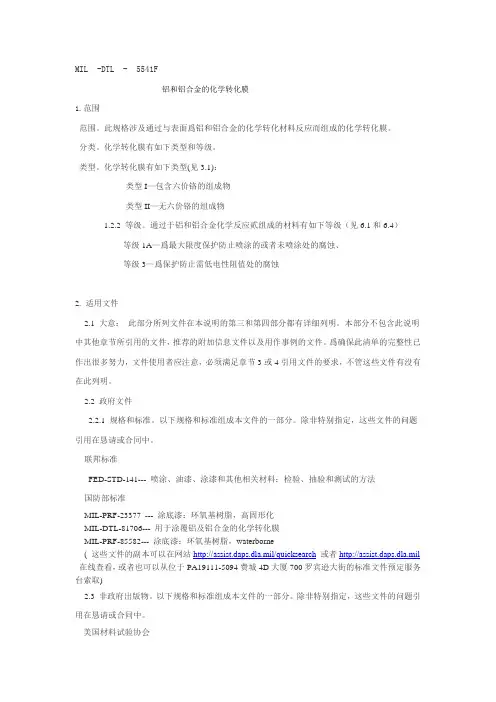
MIL -DTL - 5541F铝和铝合金的化学转化膜1.范围范围。
此规格涉及通过与表面爲铝和铝合金的化学转化材料反应而组成的化学转化膜。
分类。
化学转化膜有如下类型和等级。
类型。
化学转化膜有如下类型(见3.1):类型I—包含六价铬的组成物类型II—无六价铬的组成物1.2.2 等级。
通过于铝和铝合金化学反应贰组成的材料有如下等级(见6.1和6.4)等级1A—爲最大限度保护防止喷涂的或者未喷涂处的腐蚀、等级3—爲保护防止需低电性阻值处的腐蚀2. 适用文件2.1 大意:此部分所列文件在本说明的第三和第四部分都有详细列明。
本部分不包含此说明中其他章节所引用的文件,推荐的附加信息文件以及用作事例的文件。
爲确保此清单的完整性已作出很多努力,文件使用者应注意,必须满足章节3或4引用文件的要求,不管这些文件有没有在此列明。
2.2 政府文件2.2.1 规格和标准。
以下规格和标准组成本文件的一部分。
除非特别指定,这些文件的问题引用在恳请或合同中。
联邦标准FED-STD-141--- 喷涂、油漆、涂漆和其他相关材料:检验、抽验和测试的方法国防部标准MIL-PRF-23377 --- 涂底漆:环氧基树脂,高固形化MIL-DTL-81706--- 用于涂覆铝及铝合金的化学转化膜MIL-PRF-85582--- 涂底漆:环氧基树脂,waterborne( 这些文件的副本可以在网站/quicksearch或者 在线查看,或者也可以从位于PA19111-5094费城4D大厦700罗宾逊大街的标准文件预定服务台索取)2.3 非政府出版物。
以下规格和标准组成本文件的一部分。
除非特别指定,这些文件的问题引用在恳请或合同中。
美国材料试验协会ASTM-B117 ---- 盐雾试验仪器操作ASTM-D3359--- 胶带附着力测试(这些文件副本可以从位于PA19428-2959 ,west conshohocken,ASTM 获得或者从网站http: //了解)美国质量协会(ASQ)ASQ-Z 1.4 --- 通过属性进行程序,抽样及台板检验(此文件副本可从位于美国密尔沃基市的美国质量协会获得或从网站了解到。
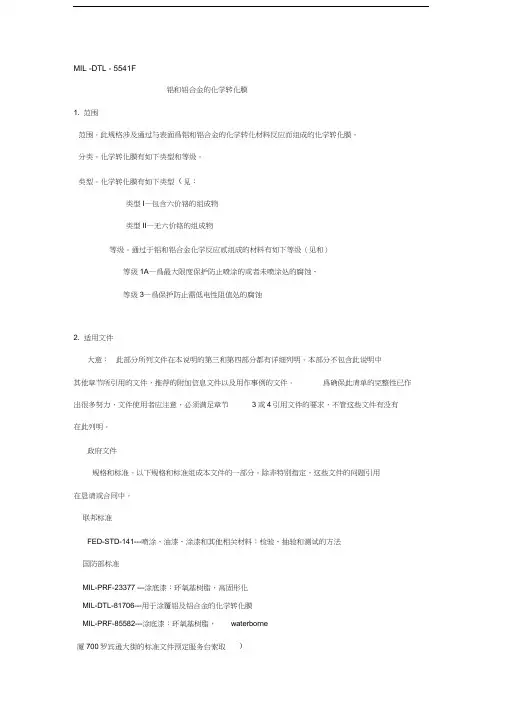
MIL -DTL - 5541F铝和铝合金的化学转化膜1. 范围范围。
此规格涉及通过与表面爲铝和铝合金的化学转化材料反应而组成的化学转化膜。
分类。
化学转化膜有如下类型和等级。
类型。
化学转化膜有如下类型(见:类型I—包含六价铬的组成物类型II—无六价铬的组成物等级。
通过于铝和铝合金化学反应贰组成的材料有如下等级(见和)等级1A—爲最大限度保护防止喷涂的或者未喷涂处的腐蚀、等级3—爲保护防止需低电性阻值处的腐蚀2. 适用文件大意:此部分所列文件在本说明的第三和第四部分都有详细列明。
本部分不包含此说明中其他章节所引用的文件,推荐的附加信息文件以及用作事例的文件。
爲确保此清单的完整性已作岀很多努力,文件使用者应注意,必须满足章节3或4引用文件的要求,不管这些文件有没有在此列明。
政府文件规格和标准。
以下规格和标准组成本文件的一部分。
除非特别指定,这些文件的问题引用在恳请或合同中。
联邦标准FED-STD-141---喷涂、油漆、涂漆和其他相关材料:检验、抽验和测试的方法国防部标准MIL-PRF-23377 ---涂底漆:环氧基树脂,高固形化MIL-DTL-81706---用于涂覆铝及铝合金的化学转化膜MIL-PRF-85582---涂底漆:环氧基树脂,waterborne厦700罗宾逊大街的标准文件预定服务台索取)(这些文件的副本可以在网站或者在线查看,或者也可以从位于PA19111-5094费城4D大非政府出版物。
以下规格和标准组成本文件的一部分。
除非特别指定,这些文件的问题引用在恳请或合同中。
美国材料试验协会ASTM-B117 ---- 盐雾试验仪器操作ASTM-D3359--- 胶带附着力测试(这些文件副本可以从位于PA19428-2959 ,west conshohocken, ASTM 获得或者从网站了解)美国质量协会(ASQ)ASQ-Z --- 通过属性进行程序,抽样及台板检验(此文件副本可从位于美国密尔沃基市的美国质量协会获得或从网站了解到。
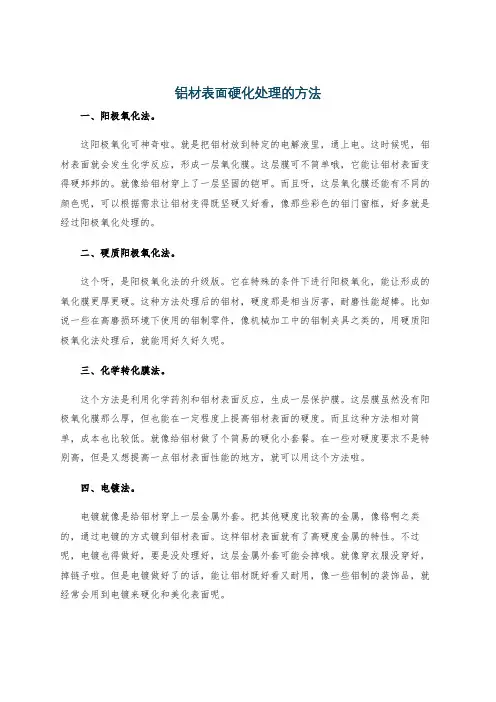
铝材表面硬化处理的方法一、阳极氧化法。
这阳极氧化可神奇啦。
就是把铝材放到特定的电解液里,通上电。
这时候呢,铝材表面就会发生化学反应,形成一层氧化膜。
这层膜可不简单哦,它能让铝材表面变得硬邦邦的。
就像给铝材穿上了一层坚固的铠甲。
而且呀,这层氧化膜还能有不同的颜色呢,可以根据需求让铝材变得既坚硬又好看,像那些彩色的铝门窗框,好多就是经过阳极氧化处理的。
二、硬质阳极氧化法。
这个呀,是阳极氧化法的升级版。
它在特殊的条件下进行阳极氧化,能让形成的氧化膜更厚更硬。
这种方法处理后的铝材,硬度那是相当厉害,耐磨性能超棒。
比如说一些在高磨损环境下使用的铝制零件,像机械加工中的铝制夹具之类的,用硬质阳极氧化法处理后,就能用好久好久呢。
三、化学转化膜法。
这个方法是利用化学药剂和铝材表面反应,生成一层保护膜。
这层膜虽然没有阳极氧化膜那么厚,但也能在一定程度上提高铝材表面的硬度。
而且这种方法相对简单,成本也比较低。
就像给铝材做了个简易的硬化小套餐。
在一些对硬度要求不是特别高,但是又想提高一点铝材表面性能的地方,就可以用这个方法啦。
四、电镀法。
电镀就像是给铝材穿上一层金属外套。
把其他硬度比较高的金属,像铬啊之类的,通过电镀的方式镀到铝材表面。
这样铝材表面就有了高硬度金属的特性。
不过呢,电镀也得做好,要是没处理好,这层金属外套可能会掉哦。
就像穿衣服没穿好,掉链子啦。
但是电镀做好了的话,能让铝材既好看又耐用,像一些铝制的装饰品,就经常会用到电镀来硬化和美化表面呢。
总之呀,不同的铝材表面硬化处理方法都有自己的优缺点,要根据实际的需求和情况来选择合适的方法哦。
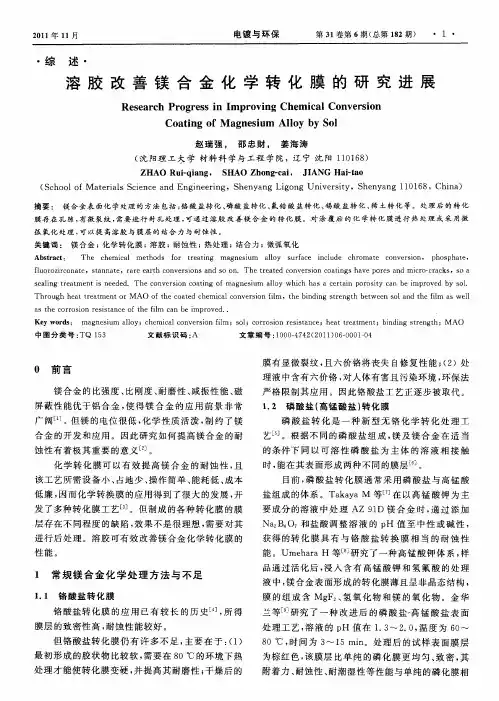
2011年11月 电镀与环保 第31卷第6期(总第182期) ・1・ ・综 述・ 溶胶改善镁合金化学转化膜的研究进展
Research Progress in Improving Chemical Conversion Coating of Magnesium Alloy by Sol
赵瑞强。邵忠财,姜海涛 (沈阳理工大学材料科学与工程学院,辽宁沈阳110168) ZHAO Rui・qiang, SHAO Zhong-cai, JIANG Hai—tao (School of Materials Science and Engineering,Shenyang Ligong University,Shenyang 1 1 0 1 6 8,China)
摘要: 镁合金表面化学处理的方法包括:铬酸盐转化、磷酸盐转化、氟锆酸盐转化、锡酸盐转化、稀土转化等。处理后的转化 膜存在孔隙,有微裂纹,需要进行封孔处理,可通过溶胶改善镁合金的转化膜。对涂覆后的化学转化膜进行热处理或采用微 弧氧化处理,可以提高溶胶与膜层的结合力与耐蚀性。 关键词:镁合金;化学转化膜;溶胶;耐蚀性;热处理;结合力;微弧氧化 Abstract:The chemical methods for treating magnesium alloy surface include chromate conversion,phosphate, fluorozirconate,stannate,rare earth conversions and SO on.The treated conversion coatings have pores and micro—cracks,SO a sealing treatment is needed.The conversion coating of magnesium alloy which has a certain porosity can be improved by so1. Through heat treatment or MAO of the coated chemical conversion film,the binding strength between so[and the film as well as the corrosion resistance of the film can be improved.. Key words: magnesium alloy;chemical conversion film;sol;corrosion resistance;heat treatment;binding strength;MAO 中图分类号:TQ 153 文献标识码:A 文章编号:1000—4742(2011)06—0001~04
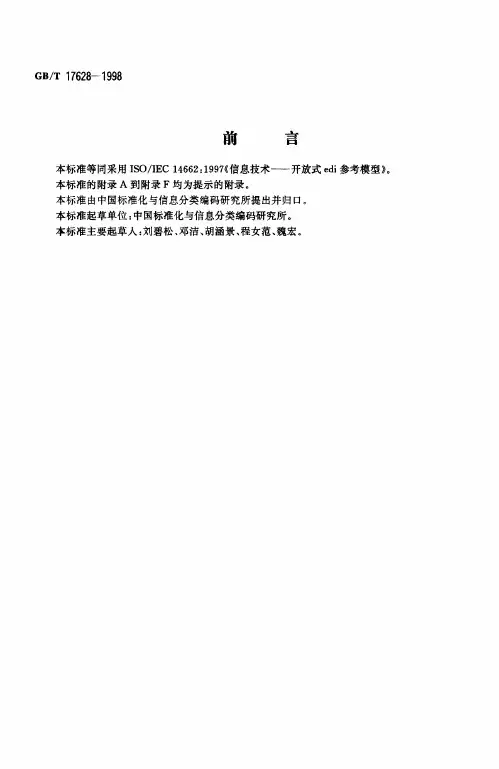
MIL-DTL-5541F_中文版铝和铝合金的化学转化膜MIL -DTL - 5541F铝和铝合金的化学转化膜1.范围范围。
此规格涉及通过与表面爲铝和铝合金的化学转化材料反应而组成的化学转化膜。
分类。
化学转化膜有如下类型和等级。
类型。
化学转化膜有如下类型(见3.1):类型I—包含六价铬的组成物类型II—无六价铬的组成物1.2.2 等级。
通过于铝和铝合金化学反应贰组成的材料有如下等级(见6.1和6.4)等级1A—爲最大限度保护防止喷涂的或者未喷涂处的腐蚀、等级3—爲保护防止需低电性阻值处的腐蚀2. 适用文件2.1 大意: 此部分所列文件在本说明的第三和第四部分都有详细列明。
本部分不包含此说明中其他章节所引用的文件,推荐的附加信息文件以及用作事例的文件。
爲确保此清单的完整性已作出很多努力,文件使用者应注意,必须满足章节3或4引用文件的要求,不管这些文件有没有在此列明。
2.2 政府文件2.2.1 规格和标准。
以下规格和标准组成本文件的一部分。
除非特别指定,这些文件的问题引用在恳请或合同中。
联邦标准FED-STD-141--- 喷涂、油漆、涂漆和其他相关材料:检验、抽验和测试的方法国防部标准MIL-PRF-23377 --- 涂底漆:环氧基树脂,高固形化MIL-DTL-81706--- 用于涂覆铝及铝合金的化学转化膜MIL-PRF-85582--- 涂底漆:环氧基树脂,waterborne或者( 这些文件的副本可以在网站在线查看,或者也可以从位于PA19111-5094费城4D大厦700罗宾逊大街的标准文件预定服务台索取)2.3 非政府出版物。
以下规格和标准组成本文件的一部分。
除非特别指定,这些文件的问题引用在恳请或合同中。
美国材料试验协会ASTM-B117 ---- 盐雾试验仪器操作ASTM-D3359--- 胶带附着力测试( 这些文件副本可以从位于PA19428-2959 ,west conshohocken, ASTM 获得或者从网站了解)美国质量协会(ASQ)ASQ-Z 1.4 --- 通过属性进行程序,抽样及台板检验( 此文件副本可从位于美国密尔沃基市的美国质量协会获得或从网站了解到。
MIL-DTL-5541F_中文版铝和铝合金的化学转化膜MIL -DTL - 5541F铝和铝合金的化学转化膜1.范围范围。
此规格涉及通过与表面爲铝和铝合金的化学转化材料反应而组成的化学转化膜。
分类。
化学转化膜有如下类型和等级。
类型。
化学转化膜有如下类型(见3.1):类型I—包含六价铬的组成物类型II—无六价铬的组成物1.2.2 等级。
通过于铝和铝合金化学反应贰组成的材料有如下等级(见6.1和6.4)等级1A—爲最大限度保护防止喷涂的或者未喷涂处的腐蚀、等级3—爲保护防止需低电性阻值处的腐蚀2. 适用文件2.1 大意: 此部分所列文件在本说明的第三和第四部分都有详细列明。
本部分不包含此说明中其他章节所引用的文件,推荐的附加信息文件以及用作事例的文件。
爲确保此清单的完整性已作出很多努力,文件使用者应注意,必须满足章节3或4引用文件的要求,不管这些文件有没有在此列明。
2.2 政府文件2.2.1 规格和标准。
以下规格和标准组成本文件的一部分。
除非特别指定,这些文件的问题引用在恳请或合同中。
联邦标准FED-STD-141--- 喷涂、油漆、涂漆和其他相关材料:检验、抽验和测试的方法国防部标准MIL-PRF-23377 --- 涂底漆:环氧基树脂,高固形化MIL-DTL-81706--- 用于涂覆铝及铝合金的化学转化膜MIL-PRF-85582--- 涂底漆:环氧基树脂,waterborne或者( 这些文件的副本可以在网站在线查看,或者也可以从位于PA19111-5094费城4D大厦700罗宾逊大街的标准文件预定服务台索取)2.3 非政府出版物。
以下规格和标准组成本文件的一部分。
除非特别指定,这些文件的问题引用在恳请或合同中。
美国材料试验协会ASTM-B117 ---- 盐雾试验仪器操作ASTM-D3359--- 胶带附着力测试( 这些文件副本可以从位于PA19428-2959 ,west conshohocken, ASTM 获得或者从网站了解)美国质量协会(ASQ)ASQ-Z 1.4 --- 通过属性进行程序,抽样及台板检验( 此文件副本可从位于美国密尔沃基市的美国质量协会获得或从网站了解到。
金属表面转化膜之一磷化的作用和分类 磷化是一种化学与电化学反应形成磷酸盐化学转化膜的过程,所形成的磷酸盐转化膜称之为磷化膜。磷化的目的主要是:给基体金属提供保护,在一定程度上防止金属被腐蚀;用于涂漆前打底,提高漆膜层的附着力与防腐蚀能力;在金属冷加工工艺中起减摩润滑使用。 金属表面在除油、除锈后,为了防止重新生锈,通常要进行化学处理,使金属表面生成一层保护膜,该膜通常只有几微米,主要起增强涂层和底材附着力的作用,较厚的膜层还能增强防锈性能。常用的表面化学转化方法有氧化、磷化、钝化三种。其中,磷化是化学处理的中心环节,是一种大幅度提高金属工件耐腐蚀能力的简单可靠、费用较低、操作简便的工艺方法,在工业上应用很广。 1、 与磷化工艺相关的标准 金属(主要指钢铁)经含有锌(Zn)、锰(Mn)、铬(Cr)、铁(Fe)等磷酸盐的溶液处理后,在基底金属表面形成一种不溶性磷酸盐膜,此种过程称为磷化。磷化使金属表面形成一层附着良好的保护膜,以磷酸锌为例,在氧化剂的存在下,所生成的磷化膜为Zn(PO)·4H0和ZnFe(PO)·4H0的结晶体。该磷化膜闪烁有光、24422223
灰色多孔(空隙率为表面积的0.5%~1.5%),膜厚通常为0.1—50μm。
关于磷化工艺,我国和国际上都有相应的标准体系,可参照执行: GB/T11376—1997 金属的磷酸盐转化膜 GB/T6807—2001 钢铁工件涂装前磷化处理技术条件 GB/T12612—1990 多功能钢铁表面处理液通用技术条件 ISO 9717—1990 (E)金属的磷酸盐转化膜——确定要求的方法 ISOl0546—1993 (E)化学转化膜——铝及铝合金上的漂洗和不漂洗铬酸盐转化膜 DIN 50942—1973 金属的磷化处理 方法原理、缩写符号和检验方法 ANSI/ASTM/AMS 2480C 涂漆基体磷化处理 2、磷化的作用 磷酸盐转化膜应用于铁、铝、锌、镉及其合金上,既可当作最终精饰 层,也可作为其他覆盖层的中间层,其作用主要有以下方面。.
AZ91D、AZ31两种镁合金表面锡酸盐化学转化膜的
研究中期报告
本研究旨在探究AZ91D和AZ31两种镁合金表面锡酸盐化学转化膜的制备及其性能。
在研究的前期,我们通过浸泡法在两种镁合金表面制备出了锡酸盐化学转化膜,并进行了表面形貌观察和成分分析。
结果显示,制备出的锡酸盐化学转化膜均具有微米级别的厚度,在扫描电子显微镜下可见多孔性结构,主要由SnO2和Mg(OH)2等化合物组成。
在研究的中期,我们进一步对两种镁合金表面的锡酸盐化学转化膜进行了性能测试。
首先,我们对其耐腐蚀性能进行了测试,结果表明锡酸盐化学转化膜能够显著提高两种镁合金的耐腐蚀性能,尤其在NaCl溶液中的耐蚀性能更为突出。
其次,我们还进行了表面硬度测试,发现锡酸盐化学转化膜能够显著提高两种镁合金表面的硬度,其中AZ91D合金的表面硬度提高了约50%。
最后,我们进行了热稳定性测试,结果显示锡酸盐化学转化膜能够在高温条件下保持较好的稳定性。
综上所述,本研究初步验证了锡酸盐化学转化膜能够显著提高两种镁合金表面的耐腐蚀性能、表面硬度和热稳定性。
然而,还需要更加深入的研究探索其制备工艺和优化方法,以期实现其在实际应用中的广泛使用。